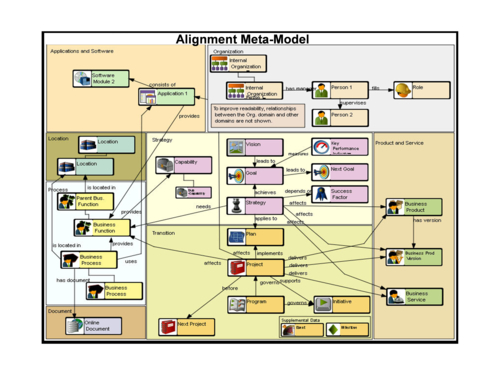This is where the Alignment meta-model of the Troux Transformation Platform becomes useful. The following figure shows the meta-model within the Troux database that supports the alignment application within Troux:

This meta-model shows how each of the key entities is related to the other, making up the complete set of metadata required to successfully perform alignment processes.
Definitions of each entity within the model include:
- Vision (vision statement): It is a statement by company officials about the broad purpose of the company. The vision statement will usually refer to the company customer base and/or the major market the company competes within. The vision of the company rarely changes.
- Strategy: It is a grouping of plans that, if carried out successfully, supports achieving company goals. There can be numerous strategies and they may be modified according to market conditions and other factors that are either in direct control of the company or outside of the company's control. Strategies depend on (critical) success factors. Success factors are assumptions that make strategies realizable.
- Goal: It is a specific objective that is measurable and achievable within the planning horizon. The planning horizon varies, but is usually within a calendar year but not usually more than three calendar years. Goals are related to key performance indicators, which serve as metrics. Goals should be assigned to organization units. Organizational units are groupings of people focused on achieving common goals.
- Program: Programs provide the rules that govern initiatives and projects. Projects have initiatives and are supported by plans. All of these entities relate to the same set of metrics that roll up to the program level.
- Project: It is a work effort that has defined starting and ending points. Projects consume resources and generate value. Value can be measured by cost reductions, revenue growth, and functionality delivered to the benefit of the company. Projects may create business products or deliver business services. Business products may exist in multiple versions.
- Business function: It is a set of procedures or set of activities that deliver products, services, or support control of the company.
- Capability: As a result of business functions, the company is able to perform tasks, deliver services, and develop products that set the company apart or allow it to compete within its industry.
- Business process: It is a procedure or activity that uses resources as input and generates a measurable output. Business processes may be automated or manual, and typically the output from one business process becomes input to a successor business process. A group of business processes organized into a predictable flow creates a business function.
- Application: It is a computerized system that supports automation for business processes. Applications contain computer programs and data sources and are managed as a single entity. Applications can be composed of software modules.
- Software module: It is a computer program that performs a discrete set of tasks. When a software module exists outside of the span of an application, it may be considered a reusable component, or service.
The relationships within the meta-model are expressed as follows:
- Vision—Leads_to—Goal
- Goal—Depends_on—Success_Factor
- Key_Performance (Indicator)—Measures—Goal
- Goal—Leads_to—Next_Goal
- Strategy—Achieves—Goal
- Strategy—Applies_to—Plan
- Strategy—Affects—Business_Product
- Strategy—Affects—Business_Product_Version
- Strategy—Affects—Business_Service
- Program—Governs—Initiative
- Program—Governs—Project
- Project—Implements—Plan
- Project—Affects—Business_Function
- Project—Delivers—Business_Service
- Project—Implements—Disaster_Recovery_Plan
- Project—Provides—Application
- Application_1—Consists_of—Application_2
- Application—Consists_of—Software_Module
- Software_Module—Consists_of—Software_Module_2
- Application—Uses—Business_Process
- Business_Process—Provides—Business_Function
- Business_Function—Provides—Capability
- Capability—has—Sub-capability
- Business_Process—Uses—Application
- Business_Function—Relates_to—Parent_Business_Function
- Business_Function—Is_Located_in—Location
- Business_Process—Is_Located_in—Location
- Business_Product—Has_Version—Business_Product_Version
- Events; Milestones; On-Line Documents (supplemental information)
As defined in the previous chapter, some of the data stored within the Alignment database may come from systems external to Troux. For example, goal information may come from a goal management system that the company uses as part of the human resource management software suite. If the company does not have a goals system, the Troux Alignment database can act as the goal repository. Another example of an external data source is a Business Process Management (BPM) application. A BPM application provides integrated development and runtime platforms that automate business processes in workflows. Workflows are typically defined by business personnel and IT typically is responsible for implementing the flows and other resources used within the flow. Data stored within the development environment of the BPM can be loaded into the Troux Transformation Platform. If a company does not have a BPM, the Troux Alignment database could be used to store information about business processes and work flows.
A company's vision and strategies are usually documented in Microsoft Word format and would need to be entered directly into the Troux Transformation Platform. The integration model shown in the previous chapter defines many different sources of information. However, Troux provides the centralized repository where information can be combined, forming the basis for measuring and reporting on alignment to company management.
This section of the chapter explains what underlying data is required to establish the aligned enterprise. The following section provides a view to alignment-related information through the user interface provided by the Troux Alignment application.
